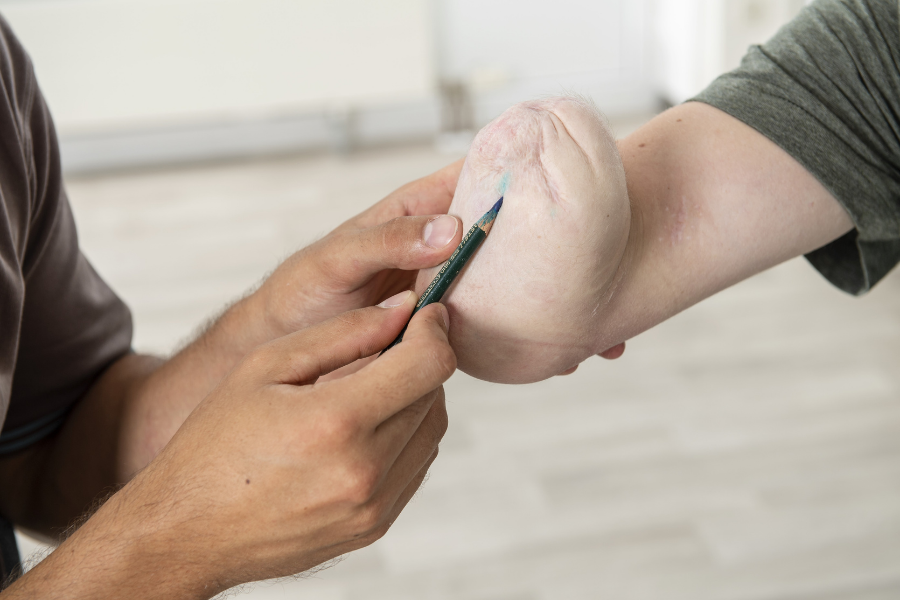Common problems with residual limbs: causes and solutions
Problems with your residual limb are common, but they can also be a major nuisance that impair you in your daily life. There are many different factors that will determine which problems you encounter, such as natural predisposition, lifestyle and personal hygiene.
If you have a residual limb, it is important that you know how to live with and care for it. It takes discipline to take good care of your residual limb- and therefore of yourself. One of the things you should do is regularly check your residual limb in the mirror, and if you wear an artificial limb, you should have it frequently checked by a specialist. It may be difficult to schedule a ‘live’ appointment because of the Corona pandemic, but remote consultations are also an option. Consider sending your specialist a photo of your residual limb, for instance!

Residual limb shape
No two residual limbs are the same, nor do they all heal in the same way. If your limb was amputated in surgery, your residual limb will generally be in better shape than if you lost your limb outside the hospital or if you were born with limb anomalies. Your scar may cause problems, and you may experience adhesions or fistulas from underlying tissue. If this is happening to you, consult your doctor. They will help you find the cause and can give you sound advice.
Skin
Your skin may also respond to amputation, possibly due to underlying skin conditions such as eczema or psoriasis. To prevent your situation from getting worse, it’s important that you consult your doctor or dermatologist. They can help you find the cause and solve the issue. A predisposition to (excessive) sweating an (excessive) body hair can also lead to skin problems. You could consider buying hypoallergenic deodorant or cream against excessive sweating. If you have too much body hair, you could consider laser treatment. Shaving is not advised, as this can lead to ingrown hairs and all sorts of other problems.
Hygiene
When it comes to hygiene, people often clean themselves either too well or not well enough. The advice is to clean your skin once a day, preferably using nothing more than water and soap. Avoid antibacterial soap, which is currently widely used to combat corona, as it dries out your skin. Overly dry skin can also lead to skin problems and, you guessed it, issues with your residual limb. Conversely, poor hygiene can also be the cause of skin problems. If you wear an artificial limb, you might encounter minor wounds and blisters, or even an infection.
For a list of products that can help, check out this article.
If you have an artificial limb, it’s important that you clean your socket and liner every day, making sure to follow the manufacturer’s instructions. For a socket, you’ll usually need nothing more than a damp cloth and isopropyl alcohol. Some liners are machine washable - just make sure to wash them at 40°C using a mild detergent. If your liner isn’t machine washable or if you don’t have the time, wash it with a skin-friendly soap and rinse well with water. You can also dab your liner with isopropyl alcohol to clean it. Whatever method you choose, always allow a liner to dry thoroughly before using it again.
Internal factors
There are many internal factors that can contribute to problems with your residual limb, such as skin allergies or side effects of medication. Diabetes and vascular disease are common causes of amputation, and poor circulation will continue to cause problems in your residual limb as well. Mental health and attitude also play a role: some people simply don’t understand what they have to do or find living with an amputation and wearing an artificial limb very difficult. If you find yourself struggling, ask a loved one or an expert for help.
Weight gain affects your residual limb, but so does weight loss, with both making it more difficult to comfortably wear your artificial limb. As difficult as it may be, try to maintain a stable weight. Muscle strength is also important, so make sure to get plenty of exercise.
This article will help you pick the right sport after losing a limb.
Artificial limb properties
Wearing an artificial limb can have a significant impact on your residual limb. An ill-fitting prosthesis, for instance, will almost certainly lead to problems, regardless of whether its too big or too small. It’s important that your artificial limb is well-balanced and that there aren’t any excessive pressure points. The support materials you use, such as your socket, liner and adhesive, also affect your residual limb.
In short: all amputations have to be taken extremely seriously. If you run into a problem, don’t keep it to yourself but seek help from an expert: they’re there to help!
Source: Martijn Pas, physiatrist at Roosdenaal’s Bravis hospital